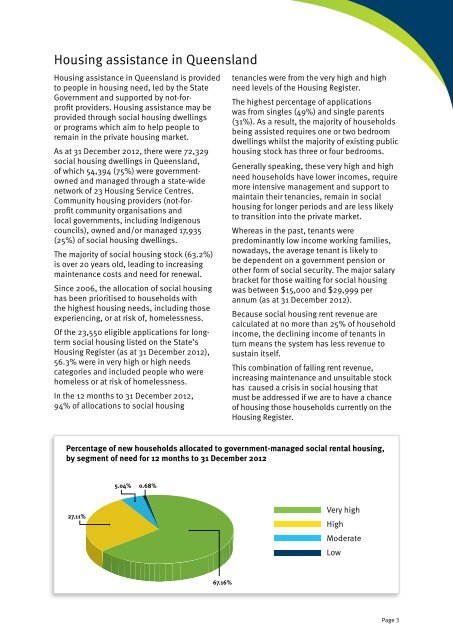Housing2020Strategy.pdf
Create successful ePaper yourself
Turn your PDF publications into a flip-book with our unique Google optimized e-Paper software.
Housing assistance in QueenslandHousing assistance in Queensland is providedto people in housing need, led by the StateGovernment and supported by not-forprofitproviders. Housing assistance may beprovided through social housing dwellingsor programs which aim to help people toremain in the private housing market.As at 31 December 2012, there were 72,329social housing dwellings in Queensland,of which 54,394 (75%) were governmentownedand managed through a state-widenetwork of 23 Housing Service Centres.Community housing providers (not-forprofitcommunity organisations andlocal governments, including Indigenouscouncils), owned and/or managed 17,935(25%) of social housing dwellings.The majority of social housing stock (63.2%)is over 20 years old, leading to increasingmaintenance costs and need for renewal.Since 2006, the allocation of social housinghas been prioritised to households withthe highest housing needs, including thoseexperiencing, or at risk of, homelessness.Of the 23,550 eligible applications for longtermsocial housing listed on the State’sHousing Register (as at 31 December 2012),56.3% were in very high or high needscategories and included people who werehomeless or at risk of homelessness.In the 12 months to 31 December 2012,94% of allocations to social housingtenancies were from the very high and highneed levels of the Housing Register.The highest percentage of applicationswas from singles (49%) and single parents(31%). As a result, the majority of householdsbeing assisted requires one or two bedroomdwellings whilst the majority of existing publichousing stock has three or four bedrooms.Generally speaking, these very high and highneed households have lower incomes, requiremore intensive management and support tomaintain their tenancies, remain in socialhousing for longer periods and are less likelyto transition into the private market.Whereas in the past, tenants werepredominantly low income working families,nowadays, the average tenant is likely tobe dependent on a government pension orother form of social security. The major salarybracket for those waiting for social housingwas between $15,000 and $29,999 perannum (as at 31 December 2012).Because social housing rent revenue arecalculated at no more than 25% of householdincome, the declining income of tenants inturn means the system has less revenue tosustain itself.This combination of falling rent revenue,increasing maintenance and unsuitable stockhas caused a crisis in social housing thatmust be addressed if we are to have a chanceof housing those households currently on theHousing Register.Percentage of new households allocated to government-managed social rental housing,by segment of need for 12 months to 31 December 20125.04% 0.68%27.11%Very highHighModerateLow67.16%Page 3



